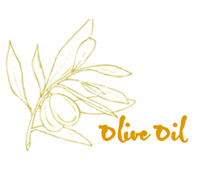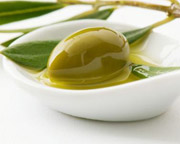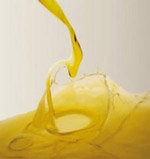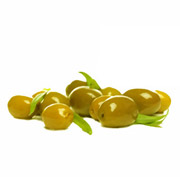Categories
- Arroces
- Cajas de Navidad
- Chocolate. Jam
- delicatessenMED Gifts
- delicatessenMED Packs
- Iberian Ham
- Iberian Sausages
- Manchego cheese
- Olive oil flavored
-
Olive Oil. Salt. Vinegar
- Olive Oil
-
Olive oil flavored
- Aceite sabor Aguacate
- Olive Oil Café Kenya flavor
- Olive oil Chive flavor
- Olive oil flavor Chocolate
- Olive oil flavor Ginger
- Olive oil flavor Horchata
- Olive oil flavor Mango
- Olive oil flavor Orange & Saffron
- Olive oil flavor Pomegranate
- Olive oil flavor Tomato Raf
- Olive oil flavor Wasabi
- Trays with 5 units
- Sea Salt flavored
- Vinegar
- Packs 'Open & Serve'
- Precooked Meals
- Saffron and Products
- Salted food
- Sugar cane "colored"
- Truffle and Products
Search
Information

I want to know more about Olive Oil 
- Production of Olive oil
- The beneficial properties of olive oil
- How to fry with oil healthfullly
- Main types of olives
- Olive D.O.
Olive oil categories
Extra virgin olive oil: Olive oil of absolutely irreproachable organoleptic characteristics, acidity expressed as oleic acid may not exceed 1 °. Suitable for direct consumption.
Virgin olive oil: virgin olive oil organoleptic characteristics irreproachable, whose acidity expressed as oleic acid may not exceed 2 °. Suitable for direct consumption. Oils similar to those above, are aromatic, soft-bodied or retaining all its vitamins and natural antioxidants, but with slight defect.
For comparison, are the equivalent of table wine.
Ordinary virgin olive oil: virgin olive oil of good taste, acidity expressed as oleic acid may not exceed 3.3 °. The legislation does not allow packaging. Not suitable for direct consumption.
It is used to lead other oils or should be refined.
"Lampante” virgin olive oil: virgin olive oil taste bad or acidity expressed in oleic acid exceeding 3.3 °. The legislation does not allow packaging. Not suitable for direct consumption. Always refined. The Roman used this oil for lighting lamps. Hence its name.
Refined olive oil: Not in the market, but is used to prepare the olive oil, for preserved-especially fish-food and other uses such as mayonnaise, margarine, etc.. Not suitable for direct consumption.
Olive oil: it is a blend of refined olive oil and virgin olive oil or extra virgin. In the market are usually the types of 0.4 ° and 1. For its smooth taste it is the most similar to seed oils. The most abundant in the market.
Olive-pomace olive oil (from crude olive): Oil from the olive pomace that requires organic solvents for extraction. Not suitable for direct consumption. Not in the market. Refined.
Refined olive pomace oil: Refined olive oil comes from crude oil. Not suitable for direct consumption.
Olive pomace oil: The oil blend of refined olive pomace oil and virgin or extra virgin olive reaching consumers.
When analyzing the process of olive oil, we must distinguish three phases:
1. Collection
This phase involves gathering the olives of the olive tree at the time they have reached the proper maturity. This is done using several more or less sophisticated techniques.
2. Milling
The traditional plant extracts in which olive oil mills are known as "almazaras". Harvested olives, are moved to the mill where screened and washed with cold water to remove leaves and debris. Is then stored in small piles to await grinding.
To obtain a quality olive oil must be processed within 24 hours of collection. Thereby avoiding alterations which modify the quality such as the fusty of the fruit a major cause of increased acidity of the oil.
Shall now proceed to grinding in a mortar or roller mill where they are ground to break the tissue in which the oil is without breaking the bone. The paste is then pressed in wrapping round esparto baskets, which act as drains, leaking fluids and retaining the solids. The liquid passed from one to another vat, decanted, therefore frees the oil substances having in suspension. There is another method instead of pressing; the slurry is stirred and centrifuged by mechanical means, without adding chemicals or heat, separating the oil from the remaining substances. The grinding and pressing olives for the extraction of virgin olive oil is made only through mechanical or physical processes.
The paste that remains is still rich in oil and squeezed again until three more times. The waste is known by the name of pomace. The first oil from pressure is the most valuable, and the following will obtain other oils of different classifications. For one liter of oil from the first extraction is needed about five kilos of olives. Consumption during the first year ensures that your qualities are intact. These oils are known under the generic name of virgin olive oil.
The acidity of an olive oil is determined by its content of free fatty acids and is expressed as grams of oleic acid per 100 grams of oil. These degrees are not related to the intensity of flavor, but are a guideline to classify olive oils.
POMACE OIL EXTRACTION
Obtaining oil which still remains in the solid secondary product (pomace) obtained after grinding and pressing of the olives.
REFINED
The chemical or physical process of refining to those undergoing virgin olive oils, which by its acidity and organoleptic characteristics are not suitable for consumption and crude pomace.
After obtaining the oils must be retained in storage tanks that meet certain conditions essential to preserve quality. They must have a certain shape and size; maintained at a temperature between 18 and 20 degrees, have soft lighting and free of odors to avoid altering the sensory characteristics of the oil.
3. Packaging:
In this last phase oils are packaged and labeled in different containers. The packaging operation is performed in chains in which, more or less automated, containers are placed, are filled, they are encapsulated, are labeled and placed in boxes or containers for shipment to retailers.
The beneficial properties of olive oil

Virgin olive oil is the juice of the olive, so it preserves all the flavor and nutritional properties of olive fruit. Olive oil is the richest in oleic acid. It is therefore a monounsaturated fat, with very beneficial effect on cholesterol, lowering the rates of LDL cholesterol and increasing HDL, good for cardiovascular problems.
And if it is extra virgin olive oil (obtained from the first cold pressing), is very rich in vitamin E, which protects the fat from the dangerous action of free radicals, resisting the oxidation that these produce on the body human.
It also has anticancer effects, and promotes digestion by stimulating the gallbladder.
Exerts a protective effect and works as a skin tonic. It stimulates growth and promotes calcium absorption and mineralization. For its vitamin E and the antioxidant effect of this on the cell membrane, olive oil is especially recommended for children and seniors (helps prevent arteriosclerosis and risks).
How to fry with oil healthfullly
In the Mediterranean diet have widespread use of olive oil, and especially for frying food. Other oils such as sunflower oil or butter are not as healthy for frying, reason: they have more polyunsaturated fatty acids, which support high temperatures worse and make the fat loss of quality.
In olive oil are abundant especially monounsaturated fatty acids, and they support high temperatures better than polyunsaturated, but over time also end up losing nutritional value. This is not to say that sunflower oil is bad, in contrast, is omega-6 essential for the body, except that consume it raw is better for more benefits.
Therefore if we are going to fry food, better choose olive oil, the fat will be oxidized less and we’ll obtain healthier and higher quality foods. However, if you fry meat or other foods with saturated fats, we are in the same situation.
Not recommended to use olive oil to fry several times. It depends on how clean it is oil, but generally not advised to use more than 5 times the same oil for frying.
Arbequina
Originally from the town of Arbeca, belonging to the region of Les Garrigues (Lleida). The Arbequina olive is small, with a maturation period between the second week of December and January the second, high productivity and good fat yield, about 21%, and are highly valued because they have a very early incorporation into production . It is one of the varieties with the highest percentage of oil extraction. Oils, with a color between green and yellow, almond-scented with a fresh and fruity scent. Its flavor varies depending on soil type and climate.
This olive is the majority in Lleida (DO Les Garrigues) and in Tarragona (OJ Siurana). We can also find them in the provinces of Zaragoza, Huesca, Teruel. The oils protected by the Denomination of Origin of Aragon support up to 20% Arbequina olives.
Cornicabra
Also called cornezuelo, this variety is originally from Mora de Toledo and is the second most widely grown variety. The name comes from the way the olive has its horn. It is grown in the provinces of Toledo and Ciudad Real, and gives rise to the appellation of origin Montes de Toledo. It is a fruit resistant to drought, and frost and severe cold. Its oils have a greenish yellow color and have fine fruity aromas and flavors of almond, showing average values of bitter and spicy, showing a balance between bitter sweet at first.
Picual
It is the most important variety in the world. Represents 20% of global olive and Spain represents 50% of olive cultivation. Its geographical spread is linked to Andalusia, the main producing region of the world and in particular the provinces of Jaen, Cordoba and Granada. It is also present in Malaga, Ciudad Real and Badajoz. It is considered the best variety of the world, and is the majority in the province of Jaen, and the designation of origin "Sierra Magina". It is also prevalent in the DO "Sierra de Segura", "Priego de Córdoba" and "Baena".
The olive trees of this variety have high productivity, which is one of the reasons that have markedly increased their plantings. It is a type of tree that adapts to different conditions of climate and soil and is tolerant to frost, but is very resistant to drought and limestone based soils. Fruit maturation takes from the second week of November to the third of December.
Has a high fat yield (reaches up to 25%), a high level of stability and a high oleic acid content. It also offers high resistance to rancidity due to the amount of natural antioxidants contained therein. Its high content in polyphenols, making it the most stable oil.
From the organoleptic point of view, are oils that have a large force, but should distinguish between the plain and the mountain. The oils are flat-bodied oils, normally bitter, with some flavor of spicy wood and light colors. The mountainous tend to be warmer but with a combination of olfactory, gustatory and trigeminal to cool and pleasant.
Hojiblanca
Its area of influence extends through Andalusia, particularly in the east of the province of Seville, southern Córdoba and all the north of the province of Malaga. You can assume 16% of the Andalusian olive grove. It is also known under the name Lucentino by metallic reflections of the leaves when given the sun. Hojiblanca olives used both for consumption and black table olives by the firm texture of its flesh, and for oil production.
The ripening of the fruit is somewhat late, from late November to late December and once it has matured the fruit is resistant to detachment, so that its collection is difficult. The yield of the variety hojiblanca oil is low, averaging 18%.
It has a very balanced combination of fatty acids with saturated fatty comparatively lower than in other oils from other varieties. They have a high oxidation stability, being recommended to keep protected from light and without excessive aeration during storage.
Lechin of Seville
This variety is characteristic of the provinces of Seville, Cordoba, Cadiz, Malaga and Huelva. Its name comes from the whitish color of its flesh and its oily juice, mixed of vegetable water and oil. This variety is well able to withstand drought and winter cold, very well adapted to limestone and poor soils. The oil content fatty acid is found in approximately 18%.
From the organoleptic point of view, is a fluid-flavored vegetable, medium bitterness and a green almond aftertaste in the mouth. It is not often the marketing of oils exclusively with the variety Lechin, but is often used to complement other varieties such as hojiblanca and Picual.
Velez-Malaga Verdial
It is a typical local variety of the region of Axarquia, on the southeast of the province of Malaga. Verdial variety of fruity oils are obtained with very sweet and nice spicy bitterness or lacking. Its composition makes it necessary to protect from heat, light and air for better conservation. In Malaga you can find monovarietal Verdial, but usually they are mixed with hojiblanca generated from the organoleptic point of view a perfect oil and average stability.
Empeltre
The variety is grown mainly Empeltre in Aragon where it occupies about 85 percent of the districts. Its cultivation area extends from the provinces of Logroño and Teruel in the Ebro Valley to the province of Tarragona, also cultivated in the Balearic Islands.
It is one of the oldest olive trees in Spain. It can reach a large scale, although their ability to engage low, so it requires the use of the graft as the primary means of expansion. In fact, the etymology of the name is found in the Catalan word "empelt" meaning graft. Its leaves are dark green and bright, its jet black hue olives are suitable for consumption as table olives and for oil production. Its fat yield is about 18%.
The fruit is ripening early, since the first week of November to the first of December.
Its oil, straw-colored yellow and old gold, the texture is smooth, smooth with a fruity, especially apple and a delicate, sweet and somewhat nutty almost never bitter or itching, so they are very palatable in the mouth.
Picuda or Picudo
The olive picuda, also known as carrasqueña of Cordoba, is probably the most emblematic variety of Córdoba and is protected by the DO Baena and Priego de Córdoba. In the village of Luque called "pajarero." This name comes because it is said that its oil is so sweet that at the time of ripening the birds peck at the fruit. This variety is widespread in the provinces of Cordoba, Granada, Malaga and Jaen.
Fruit maturation period between the fourth week of November until the end of December and the fat yield is high, short picual values, but with figures close to 20%. Olives are also intended to be used as table olives.
The organoleptic characteristics of the variety Picuda are very good, with excellent balance and sweetness without harsh flavors. Sometimes you can find light flavors and aromas reminiscent of exotic fruits as well as apple and almond. For its fatty acid composition, the Picuda is placed in the sensitive range of oils to oxidation, which is complemented with other varieties like the Picual.
Manzanilla Cacereña
This variety known in Portugal as "negrinha and azeitera" grown in the High Extremadura (Sierra de Gata, Hurdes, Jerte Valley and Vera). It occupies an area of 95% of the olive groves of this area and the variety is protected designation of origin Gata-Hurdes.
It is intended for both the mill and the table. Gives oils which exhibit good body, with herbal aromas, spicy and bitter in the midrange to high and aromas of nuts / as mature, especially sweet banana.
Blanqueta
It is the main variety of the Spanish Levant, whose name refers to the light color of the olive. Very productive, but sensitive to sudden temperature changes and harsh winters, the oil is very aromatic and with high levels of linoleic acid. The most famous oils come from the regions of Sierra Espadán and mountain of Alicante.
Moorish
This variety is very resistant to drought, spreads over the province of Badajoz, in what is the Lower Extremadura, occupying 53% of the olive grove of the Badajoz region of Tierra de Barros. In Portugal occupies the Alentejo and the Algarve.
The verdial is used for both table olives and for oil production, which are prized for their high fat yield around 22%. Are oils with a medium-high fruitiness and the taste is slightly bitter and spicy.
Aceite Campo de Calatrava
Aceite Campo de Montiel
Aceite de la Alcarria
Aceite de la Comunitat Valenciana
Aceite de La Rioja
Aceite de l’Empordà
Aceite de Mallorca
Aceite de Navarra
Aceite de Terra Alta
Aceite del Baix Ebre
Montsià
Aceite del Bajo Aragón
Aceite Monterrubio
Antequera
Baena
Estepa
Gata-Hurdes
Les Garrigues
Lucena
Montes de Granada
Montes de Toledo
Montoro-Adamuz
Poniente de Granada
Priego de Córdoba
Sierra de Cádiz
Sierra de Cazorla
Sierra de Segura
Sierra Mágina
Siurana
Cart
No products
Shipping*
0,00 €
Total
0,00 €
Other destinations, please check Shipping Info










